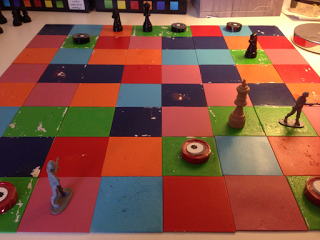Coloured Capers
- Chris Bowler
- Aug 15, 2017
- 4 min read
Updated: Sep 17, 2019
As you may recall last week I wrote a preview for Tom Norfolk's Lure, well now here's Tom himself to talk about the game and the countless sleepless nights he had while devising it!
A design diary for ‘Colour Chess + Lure’

The first game I released, Stak Bots, was definitely not the first game I made. During its design it took many forms, several of which were completely different games.
At the time, I kept leaving versions and moving on, always trying to make the game that little bit more playable, that smidgeon more fun. A small tweak would turn into a whole night sat re-designing, re-printing and re-sticking every single card, which more often than not wouldn’t work and would mean you just over-excitedly borked a whole load of cards in the process, as you scribble over the top of existing ones until all that remains is a garbled indecipherable mess.
Sometimes though, the changes would stick and the game would evolve, but the cast-offs were not forgotten. Several years after its release, the previous versions still occupy boxes as the shades of Stak Bots’ previous lives and I dig into them occasionally, nostalgically wondering when I’ll ever find the time to revisit and finish them.

A play-testing session with bits of paper taped to the back of coins!
Things worked out a little differently with the new release, where the original game which the later version grew out of has survived! They are totally different games, yet play on the same board, so there seemed little point in releasing them separately, hence we arrive at ‘Colour Chess + Lure’. Lure was a finished game almost from the moment it popped into my head, a concept that dribbled out of nothingness and somehow manifested itself like the deranged ramblings of a lunatic – “The colours! What if you could control people with the colours?!?” A few days of gameplay tweaks and testing and it was basically done.

And then it sat there. Finished. A very odd feeling indeed. The urge to tamper passed me by and I turned to work on other games.
A while later, that urge returned as an incessant tickling and I dug the game back out and toyed with adding new pieces to it. More whiles later, I stuck a Chess piece in and found that although it moved completely differently, the game mechanics still held true and gave the game a whole new tilt.
Then I tried it with another piece. Then another, then ALL OF THEM.
And Colour Chess was born...

But there were complications…
Knights bounded across the board effortlessly, ending games in a few turns; standard check rules just didn’t work. The game was a mess.
A few modifications to the standard Lure rules were made to incorporate this over the space of months, while different combinations of changes were tested to get the feel of the game right.
Eventually it got to a point where I was happy to call it finished, and it faced its real test – how would chess players and non-chess players take to it?
In short, strangely well! Non-chess players liked that it killed off needing to learn standard openings, so worked as a kind of leveller and gave a new lease of life to a game they’d learnt as a kid but had since neglected. Serious chess players found the odd positions and difference in calculation to be very interesting and a different challenge.
So the games were finished, no need to tinker anymore. Just start the endless joys of promo and publishing? Right?
NO! LOTS MORE TINKERING!

I have no idea what is happening here, I think I lost some of the Knights and borrowed some soldiers!
One of the discarded Colour Chess versions where all the pieces moved at once got fixed and became Swarm Colour Chess.

Seeing as Chess pieces worked in Lure, it had to work the other way round right? Pretty much! It just needed a BIGGER BOARD! (or odd piece arrangements).
This led to modular board experiments and tiny and oversize games.
Colour Chess is complicated moaned a few, so I made a simpler version – Sequence Colour Chess, which turned out to possibly be even more complicated.
So I made another simpler version, Switch Colour Chess, which turned out to be even more complicated again! HOW?!?

By removing player choice and making things more predetermined it stripped away potential complexity, but it also allowed you to see further ahead. Much further ahead. Painfully far ahead. I think I will stop trying to make games simpler.
Hey, this Colour Chess idea’s pretty cool said Amanda Ross at London’s Casual Chess Café; you should do Colour Go as well…
So I didn’t sleep that night, and then Colour Go was a thing. And it was fun. And then I remembered I had to do more promo for the Kickstarter instead of playing games.
So what am I trying to say in all this?
At what point is a game really finished?! When you get fed up of playtesting it? Or when more than a few months have passed without tampering with it? Is it ever done? 2nd edition, 3rd edition etc Don’t forget your past prototypes. Show them some love now and again as you never know how they’ll develop
I never set out to ‘mess with Chess’ as some people seem to think. Why would you? It’s an awesome game that’s been distilled over hundreds of years into its current form. I simply made a different game, the mechanics were applicable, and people enjoyed playing it, so I’m getting it printed so more people can enjoy it
You get a lot of game for your money. In one box there is a modular board and a whole bunch of games that play on it.
Comments